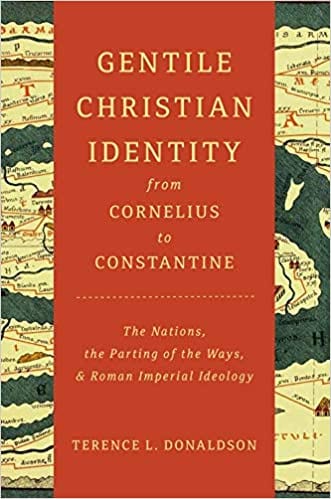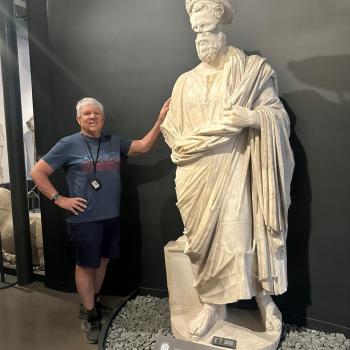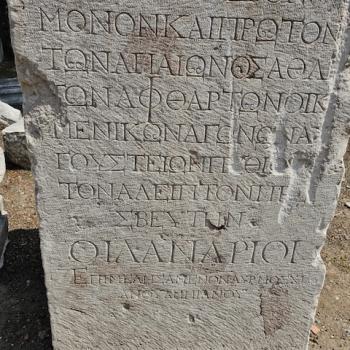Q. Obviously, there are limitations to any methodology. It has been said that methodology is not an indifferent net. It catches what it intends to catch. One of the limitations of social identity theory is it focuses on socialization in various forms focusing on terms used by converts and others as self-descriptors even in its analysis of what can be called conversion. There doesn’t seem to be much if any discussion of the role conversion experiences play in the process of conversion, for instance in the case of Paul himself. Would you see this as a fault in theory itself or just a limitation because no methodology can cover all the aspects of a religious movement like the Christ following movement?
A. I quite agree that methodologies come with intrinsic limitations. As interpretive tools, they—like the hammers or wrenches in our household toolboxes—are very useful in what they are able to do, but the extent of their usefulness very much depends on the task at hand. In our enterprise, there is a close connection between the questions that we want to ask with respect to our source material and the methodological tools that are appropriate for each possible task.
In my experience, the relationship between question and method has moved in both directions. In some cases, I have become interested in a method and then have realized its usefulness for questions in which I already had an interest. After having been trained in redaction criticism, for example, in the mid-1980s I read a couple of books on narrative criticism (Kingsbury on Matthew, Culpepper of John, Alter on biblical narrative) and came to realize both the limits of redaction criticism and the usefulness of a narrative approach for the range of questions that already interested me with respect to the Gospels. My experience with rhetorical criticism has been somewhat similar, though I haven’t done the kind of extensive work in this area that you have done. On the other hand, sometimes it has been the nature of the question itself that has led me in search of appropriate methods. To pick up the matter of conversion, the project that resulted in my monograph on Paul began with the question of how to understand the process by which his Damascus experience precipitated his transformation from one who was “a zealot for the tradition of his ancestors” (Gal 1:14) to his role as “apostle to the gentiles.” This led me to search for useful tools, which I discovered in contemporary studies of conversion, Thomas Kuhn’s analysis of cognitive transformations in The Structure of Scientific Revolutions and the sociology of knowledge more generally.
My work on ethnē as an identity term belongs to this latter category. The question of what gentile believers thought of this term and its possible usefulness leads naturally and directly to studies of social identity and ethnicity. I suppose it’s possible to identify a related question with respect to conversion: What can we say about the realities of conversion as it was experienced by gentiles in the early Christian movement and the place of this term in specific cases? Given the limitations of our sources, however, this would be a difficult task; we don’t have all that many first-person accounts in the early period, and the ones that are available (e.g., Justin, Tatian) are written very much after the event and thus reflect the way in which they have come to understand their new identity after a period of socialization rather than how the conversion was experienced at the outset. In any case, however, the method needs to be commensurate with the question and this (i.e., conversion) is not the question that I wanted to pursue.
BEN: What happened after the first century?
TERRY: By the middle of the second century, however, this state of affairs has changed dramatically. In the writings of the early gentile Christian apologists—Justin Martyr being the first major example—ethnē appears prominently as part of the apologetic enterprise of presenting Christian belief and identity in terms that would win a hearing among intelligent Greco-Roman outsiders. Broadly speaking, there were two aspects to this enterprise.
One had to do with the relationship between Christianity and Judaism. Antiquity was a highly valued commodity in the Greco-Roman world, and a people group that wanted to defend or establish itself as a respected part of that world had to engage in what can be described as competitive ethnography. The Christians’ primary claim to antiquity had to do with their Jewish origins, but this claim met a lot of headwind when it was put forward by gentiles. In my work on anti-Judaism in early Christian tradition, I had been well aware of the exegetical argument “against the Jews”—the supersessionist claims that God had rejected the Jews and had chosen the (gentile) Christians to take their place. Looking at this material again with new questions in mind, I was struck at the central role played by the term ethnē (and its Latin equivalents) in all of this. For Justin, Tertullian and others, “we gentiles” was equivalent to “we Christians.” (I might mention in passing that they also presented this church drawn from “all the nations” as constituting a new race or nation, which they also claimed to be the “true Israel,” the nation promised to Abraham.)
The other aspect of this enterprise had to do with the place of “the nations” in Roman imperial ideology. Rome prided itself not only on its conquest of the other nations, but also on civilizing the barbarian nations and drawing “all the nations” (omnes gentes) into a peaceable trans-ethnic empire. To give just one (striking!) example, Cicero describes Rome as “the light of the whole world and the fortress of all the nations.” In this context, Christian apologists strove to present Christ as a better way of drawing all the nations into a trans-ethnic unity, and the church, consequently, as an empire-like people, a kind of counter-empire.
Ultimately, the success of this apologetic enterprise exceeded even the wildest dreams of Justin Martyr and the other early apologists. With Constantine’s new support of the church, the empire-like people readily made the transition from counter-empire to imperial partner. I begin the book, actually, with an account of the oration that Eusebius, the bishop of Caesarea, presented at the dedication of the Church of the Holy Sepulchre in Jerusalem (335 CE), which Constantine had commissioned as an expression of his religious allegiance. In this remarkable speech, Eusebius presents the church and the empire as partners in one grand enterprise of gathering all the nations (ethnē) of the world into a harmonious unity, thus fulfilling the promise that Christ “shall have dominion from sea to sea and from the river to the ends of the earth.” In this enterprise, church and empire appear as similar and complementary entities, with “the nations” representing the fundamental building blocks of each.













